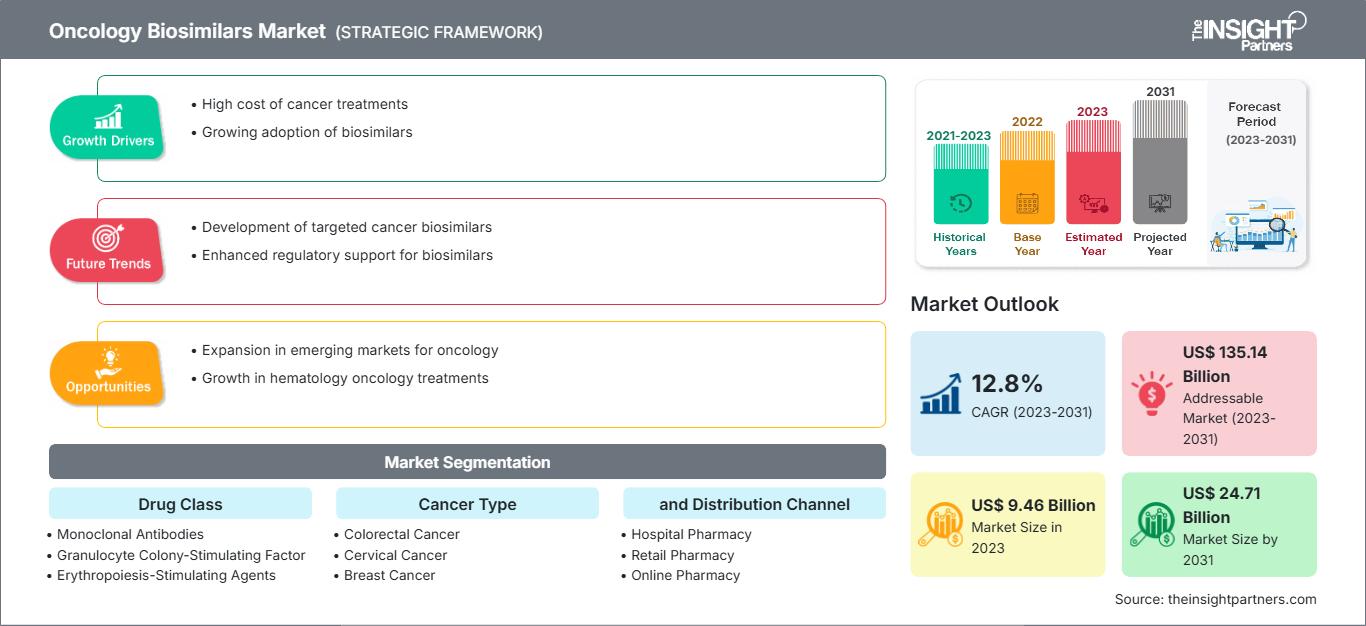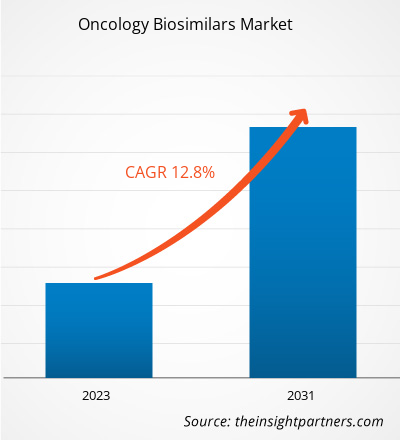[調査レポート] 腫瘍学バイオシミラー市場は、2023年に94億6,000万米ドルと評価され、2031年には247億1,000万米ドルに達すると予測されています。また、2023年から2031年にかけて12.8%のCAGRで成長すると予測されています。
市場分析とアナリストの見解:
バイオシミラーは、安全性、有効性、品質の点で既存のバイオ医薬品と非常によく似ていますが、同一ではありません。モノクローナル抗体や支持剤(フィルグラスチム、ペグフィルグラスチム、エポエチンα、エポエチンζなど)などのバイオシミラーは、さまざまな種類のがんの治療に利用できます。がん発症率の急増、バイオシミラーの費用対効果、腫瘍バイオシミラーの承認件数の増加といった要因に加え、バイオシミラーおよび臨床試験におけるメーカー間の連携が、今後数年間で腫瘍バイオシミラー市場に新たなトレンドをもたらすことが期待されています。しかしながら、バイオシミラー製品の製造における高コストと複雑さは、市場の阻害要因の一つとなっています。
腫瘍バイオシミラー市場の規模とシェア – 市場牽引要因:
世界保健機関(WHO)によると、2022年には世界中で約2,000万人の新規がん症例と970万人のがんによる死亡が報告されています。さらに、WHOの世界がん観測所による最新の推計によると、2022年には10種類のがんが世界の新規がん症例と死亡の約3分の2を占めました。これらのうち、肺がんは世界で最も多く発生しているがんで、新規症例250万件、新規症例全体の12.4%を占めました。女性乳がんは230万件で2位、新規症例全体の11.6%を占め、大腸がんが続き、新規症例全体の9.6%を占めました。前立腺がんは150万件で4位、胃がんは97万件で5位でした。より手頃な価格の腫瘍バイオシミラーが医療装備として登場することで、実際のシナリオで実証された安全性と有効性、臨床的証拠、および物理化学的品質データにより、医療費の負担が軽減され、効率的ながん治療へのアクセスが改善される可能性があります。例えば、2023年7月にMultidisciplinary Digital Publishing Institute(MDPI)が発表した論文では、がん治療に使用されるバイオシミラーモノクローナル抗体(mAb)の安全性情報を対応する先行医薬品と比較・記述する研究が行われ、市販後医薬品安全性監視データも評価されました。この研究では、ベバシズマブ、トラスツズマブ、リツキシマブのバイオシミラーとその先行品の安全性プロファイルに有意な差異は認められないと結論付けられました。この結果は、バイオシミラーの安全性の同等性を検証し、バイオ医薬品の先行品の競争力のある代替品としての使用を裏付けました。したがって、がんの負担の増大とがんによる死亡者数の増加は、手頃な価格の治療法の必要性を生み出し、腫瘍バイオシミラー市場の成長を後押しすると考えられます。
要件に合わせてレポートをカスタマイズ
レポートの一部、国レベルの分析、Excelデータパックなどを含め、スタートアップ&大学向けに特別オファーや割引もご利用いただけます(無償)
腫瘍バイオシミラー市場: 戦略的洞察

-
このレポートの主要な市場動向を入手してください。この無料サンプルには、市場動向から見積もりや予測に至るまでのデータ分析が含まれます。
セグメンテーションと範囲:
「腫瘍バイオシミラー市場の分析と2030年までの予測」は、世界的な市場のダイナミクスに焦点を当てた専門的で詳細な調査であり、主要な推進要因、将来の市場動向、および収益性の高い市場機会を特定するのに役立ちます。これにより、主要な収益ポケットを特定するのに役立ちます。レポートは、薬物クラス、がんの種類、および流通チャネルに基づいて詳細な市場セグメンテーションとともに市場の概要を提供することを目的としています。レポートには、主要な市場プレーヤーとその主要な戦略的開発に関する包括的な分析も含まれています。腫瘍バイオシミラー市場レポートの範囲には、北米、ヨーロッパ、アジア太平洋、南米および中米、中東およびアフリカにおける市場パフォーマンスの評価が含まれます。アフリカ。
セグメント評価:
市場は、薬物クラスに基づいて、モノクローナル抗体、顆粒球コロニー刺激因子、および赤血球造血刺激因子(ESA)に分類されます。2023年には、モノクローナル抗体セグメントが腫瘍バイオシミラー市場で最大のシェアを占め、2023年から2031年にかけて最高のCAGRを記録すると予想されています。モノクローナル抗体は、リガンド受容体の増殖および生存経路を阻害するなど、複数の方法で癌細胞を破壊することができます。主な作用機序は、抗体依存性細胞傷害(ADCC)と補体介在性細胞傷害です。リツキシマブ、トラスツズマブ、ベバシズマブは、2019年12月まで欧州医薬品庁(EMA)と米国食品医薬品局(FDA)によってがん治療薬として承認されていたバイオシミラーモノクローナル抗体でした。
がんの種類に基づいて市場は、大腸がん、子宮頸がん、乳がん、支持療法、リンパ腫などに分類されています。支持療法セグメントは2023年に最大の市場シェアを占めました。大腸がんは2023年から2031年にかけて最も高いCAGRを記録すると予測されています。WHOによると、がんは重大な健康問題であり、世界中で主な死亡原因となっています。がんの罹患率が増加する中、多くの腫瘍バイオシミラーメーカーが新製品の開発と市場投入に取り組んでいます。たとえば、Celltrion 社の CT-P16、Prestige Biopharma 社の 163 HD204、Cipla Biotech 社の CBT124、Beijing Mabworks Biotech 社の MIL60 は、ベバシズマブの潜在的なバイオシミラーであり、現在第 3 相試験が行われており、安全性と有効性のパラメータについて比較されています。バイオシミラーは、非小細胞肺がんの患者の治療能力についても評価されています。
流通チャネルに基づいて市場は、病院薬局、小売薬局、オンライン薬局に分類されています。2022年には、病院薬局セグメントが最大の市場シェアを占めました。オンライン薬局セグメントは、2023年から2031年にかけて最高のCAGRを記録すると予想されています。病院薬局は、患者がバイオシミラーなどの処方薬を購入できる主要なプラットフォームです。
地域
分析:
収益の面では、北米が2023年に腫瘍学バイオシミラー市場の主要なシェアを占め、ヨーロッパがそれに続きました。がん患者の増加、がん治療用バイオシミラーの承認の増加、および高度な医療インフラは、予測期間中に北米の腫瘍学バイオシミラー市場を推進すると予想される要因です。
がん患者の増加、がん治療用バイオシミラーの承認の増加、および高度な医療インフラは、北米の腫瘍学バイオシミラー市場を推進すると予想される要因です。生物学的製剤は米国で最も高価な医薬品です。バイオシミラーは、その参照製品よりも費用対効果が高いと期待されています。2022年10月にPubMed Centralによって公開された記事では、2021年6月時点の米国の薬価に基づき、生物学的製剤とバイオシミラーの1単位あたりの平均卸売価格(AWP)を使用してコスト比較が行われました。分析によると、バイオシミラーはベバシズマブで15~23%の節約をもたらす可能性があります。ベバシズマブのバイオシミラーの中で、ジルベスは先発品であるアバスチンと比較して大幅に高いコスト削減効果を発揮します。フィルグラスチムなどのがん治療薬のバイオシミラーは、先行品と比較して17.3%から34%のコスト削減効果を発揮し、ペグフィルグラスチムのバイオシミラーは33%から37%のコスト削減効果を発揮します。また、エポジェンのバイオシミラーは33.5%のコスト削減効果を発揮します。2022年に発表されたカーディナルヘルス社のバイオシミラーレポートによると、米国ではFDAが33のバイオシミラーを承認しており、そのうち21が市販されています。このうち17ががん治療に使用されています。同情報源によると、バイオシミラーは2025年までに米国の医薬品支出を1,330億ドル削減すると予想されています。したがって、米国では、バイオシミラーは生物学的医薬品のコストを下げ、患者が治療を受けやすくし、イノベーションと科学的ブレークスルーを生み出し、この地域の腫瘍バイオシミラー市場を牽引する大きな可能性を秘めています。
腫瘍バイオシミラー
腫瘍バイオシミラー市場の地域別分析The Insight Partnersのアナリストは、予測期間を通じてオンコロジーバイオシミラー市場に影響を与える地域的な動向と要因を詳細に解説しています。このセクションでは、北米、ヨーロッパ、アジア太平洋、中東・アフリカ、中南米におけるオンコロジーバイオシミラー市場のセグメントと地域についても解説しています。
腫瘍バイオシミラー市場レポートの範囲
| レポート属性 | 詳細 |
|---|---|
| の市場規模 2023 | US$ 9.46 Billion |
| 市場規模別 2031 | US$ 24.71 Billion |
| 世界的なCAGR (2023 - 2031) | 12.8% |
| 過去データ | 2021-2023 |
| 予測期間 | 2023-2031 |
| 対象セグメント |
By 薬物クラス
|
| 対象地域と国 |
北米
|
| 市場リーダーと主要企業の概要 |
|
腫瘍バイオシミラー市場のプレーヤー密度:ビジネスダイナミクスへの影響を理解する
オンコロジーバイオシミラー市場は、消費者の嗜好の変化、技術の進歩、製品ベネフィットに対する認知度の高まりといった要因によるエンドユーザーの需要増加に牽引され、急速に成長しています。需要の増加に伴い、企業は製品ラインナップの拡充、消費者ニーズへの対応のためのイノベーション、そして新たなトレンドの活用を進めており、これが市場の成長をさらに加速させています。

- 入手 腫瘍バイオシミラー市場 主要プレーヤーの概要
業界の発展と将来の機会:
腫瘍学バイオシミラー市場の予測は、この市場の関係者が成長戦略を計画するのに役立ちます。同社のプレスリリースによると、腫瘍学バイオシミラー市場で活動している主要企業による主要な開発と取り組みは次のとおりです。
- 2022年11月、オルガノンはカナダでアバスチンのバイオシミラーであるAYBINTIOを発売しました。この治療薬は、転移性大腸がん(mCRC)、転移性肺がん、プラチナ感受性および抵抗性の再発性上皮性卵巣がん(卵管がんおよび原発性腹膜がんを含む)、および神経膠芽腫など、特定の攻撃的な形態のがんに罹患したカナダの患者に利用可能です。今回の発売は、同社のバイオシミラーポートフォリオの拡大を目的としています。
- 2022年5月、バイオコン・バイオロジクスとビアトリスは、ロシュ社のアバスチン(ベバシズマブ)のバイオシミラーであるAbemyを発売しました。バイオコン社の子会社であるバイオコン・バイオロジクス社とビアトリス社は、この腫瘍学バイオシミラーをカナダで販売開始すると発表しました。バイオコン・バイオロジクス社とビアトリス社が共同開発したbevyは、カナダ保健省により4種類のがんに対する承認を取得しています。
- 2020年4月、ファイザーは、モノクローナル抗体(mob)であり、マザー(リツキシマブ)のバイオシミラーであるRUXIENCEの承認を欧州委員会(EC)から取得しました。この承認は、非ホジキンリンパ腫(NHL)、慢性リンパ性白血病(CLL)、自己免疫疾患などの特定のがんの治療を対象としています。
- 2020年1月、コーラス・バイオサイエンスは、米国とカナダで、あらゆる剤形およびプレゼンテーションのベバシズマブ(アバスチン)バイオシミラーの開発および商品化について、イノセンツ・バイオロジクス社とライセンス契約を締結しました。
競合状況と主要企業:
腫瘍学バイオシミラー市場レポートで紹介されている主要企業には、CELLTRION, Inc.、Teva Pharmaceutical Industries Ltd、Pfizer Inc、Sandoz Group AG、Biocon、Amgen Inc、Samsung Bioepis、Coherus BioSciences、BIOCAD、およびLillyが含まれます。これらの企業は、世界中で高まる消費者の需要を満たすために、新しいハイテク製品の提供、既存製品の技術的進歩、地理的拡大に重点を置いています。
- 過去2年間の分析、基準年、CAGRによる予測(7年間)
- PEST分析とSWOT分析
- 市場規模価値/数量 - 世界、地域、国
- 業界と競争環境
- Excel データセット
最新レポート
関連レポート
お客様の声
購入理由
- 情報に基づいた意思決定
- 市場動向の理解
- 競合分析
- 顧客インサイト
- 市場予測
- リスク軽減
- 戦略計画
- 投資の正当性
- 新興市場の特定
- マーケティング戦略の強化
- 業務効率の向上
- 規制動向への対応






















 無料サンプルを入手 - 腫瘍バイオシミラー市場
無料サンプルを入手 - 腫瘍バイオシミラー市場